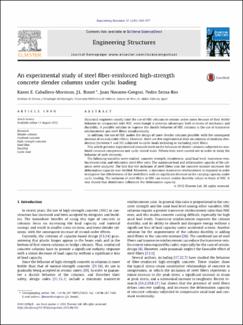An experimental study of steel fiber-reinforced high-strength concrete slender columns under cyclic loading
Date
2012-08-102012-08-10
Author
Caballero Morrison, Karen E.
Bonet, José L.
Gregori, Juan Navarro
Metadata
Show full item recordAbstract
Structural engineers usually limit the use of HSC columns to seismic active zones because of their britle behavior in comparison with NSC, even though it presents advantages both in terms of mechanics and durability. A possible solution to improve the ductile behavior of HSC columns is the use of transverse reinforcement and steel fibers simultaneously.
In addition, the use of HSC makes the design of more slender columns possible, with the consequent increase of second-order effects. However, there are few experimental tests on columns of medium slenderness (between 5 and 10) subjected to cyclic loads including or excluding steel fibers.
This article presents experimental research work on the behavior of slender columns subjected to combined constant compression and cyclic lateral loads. Fifteen tests were carried out in order to study the behavior of such elements.
The following variables were studied: concrete strength, slenderness, axial load level, transverse reinforcement ratio, and volumetric steel-fiber ratio. The maximum load and deformation capacity of the columns were analyzed. The fact that the inclusion of steel fibers into the concrete mixture increases the deformation capacity was verified. Moreover, a minimum transverse reinforcement is required in order to improve the effectiveness of the steel fibers with no significant decrease in the carrying capacity under cyclic loading. The inclusion of steel fibers in HSC can ensure similar ductility values to those of NSC. It was shown that slenderness influences the deformation capacity.
In addition, the use of HSC makes the design of more slender columns possible, with the consequent increase of second-order effects. However, there are few experimental tests on columns of medium slenderness (between 5 and 10) subjected to cyclic loads including or excluding steel fibers.
This article presents experimental research work on the behavior of slender columns subjected to combined constant compression and cyclic lateral loads. Fifteen tests were carried out in order to study the behavior of such elements.
The following variables were studied: concrete strength, slenderness, axial load level, transverse reinforcement ratio, and volumetric steel-fiber ratio. The maximum load and deformation capacity of the columns were analyzed. The fact that the inclusion of steel fibers into the concrete mixture increases the deformation capacity was verified. Moreover, a minimum transverse reinforcement is required in order to improve the effectiveness of the steel fibers with no significant decrease in the carrying capacity under cyclic loading. The inclusion of steel fibers in HSC can ensure similar ductility values to those of NSC. It was shown that slenderness influences the deformation capacity.
